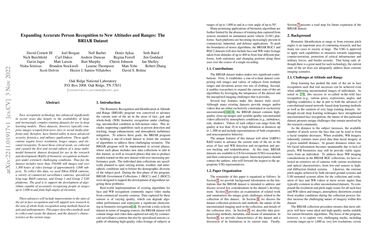Expanding Accurate Person Recognition to New Altitudes and Ranges: The BRIAR Dataset
Face recognition technology has advanced significantly in recent years due largely to the availability of large and increasingly complex training datasets for use in deep learning models. These datasets, however, typically comprise images scraped from news sites or social media platforms and, therefore, have limited utility in more advanced security, forensics, and military applications. These applications require lower resolution, longer ranges, and elevated viewpoints. To meet these critical needs, we collected and curated the first and second subsets of a large multi-modal biometric dataset designed for use in the research and development (R&D) of biometric recognition technologies under extremely challenging conditions. Thus far, the dataset includes more than 350,000 still images and over 1,300 hours of video footage of approximately 1,000 subjects. To collect this data, we used Nikon DSLR cameras, a variety of commercial surveillance cameras, specialized long-rage R&D cameras, and Group 1 and Group 2 UAV platforms. The goal is to support the development of algorithms capable of accurately recognizing people at ranges up to 1,000 m and from high angles of elevation. These advances will include improvements to the state of the art in face recognition and will support new research in the area of whole-body recognition using methods based on gait and anthropometry. This paper describes methods used to collect and curate the dataset, and the dataset's characteristics at the current stage.
PDF Abstract



 IJB-C
IJB-C